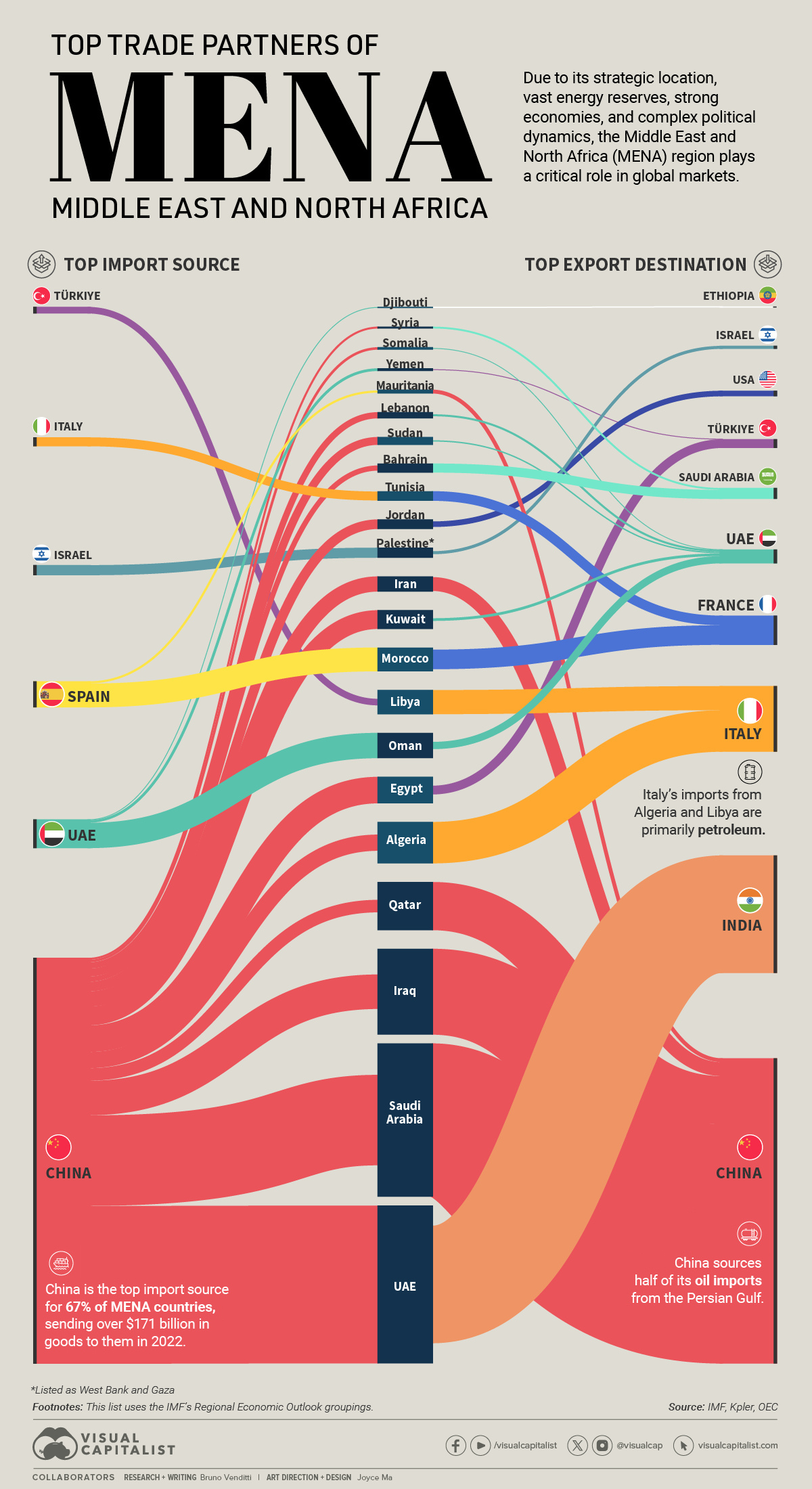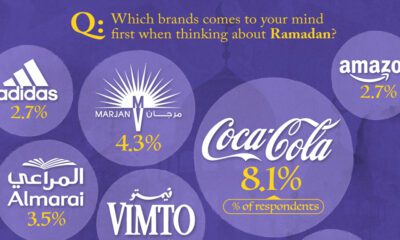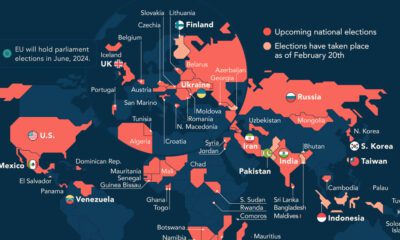Markets
Visualizing the Top Trading Partners of MENA Countries
![]() See this visualization first on the Voronoi app.
See this visualization first on the Voronoi app.
Visualizing the Top Trading Partners of MENA Countries
This was originally posted on our Voronoi app. Download the app for free on iOS or Android and discover incredible data-driven charts from a variety of trusted sources.
Due to its strategic location, vast energy reserves, strong economies, and complex political dynamics, the Middle East and North Africa (MENA) region plays a critical role in global markets.
In this graphic, we visualize the top trading partners of the MENA countries based on data from the International Monetary Fund (IMF), as of October 2023.
China: The Top Import Partner of MENA
China dominates as the top import supplier to MENA countries. The Asian country sent over $171 billion in goods to the region in 2022.
| Country | Top Import Partner | Imports (Million USD) |
|---|---|---|
| 🇩🇿 Algeria | China | $6,994 |
| 🇩🇯 Djibouti | UAE | $325 |
| 🇪🇬 Egypt | China | $11,461 |
| 🇱🇾 Libya | Türkiye | $2,842 |
| 🇲🇷 Mauritania | Spain | $952 |
| 🇲🇦 Morocco | Spain | $10,265 |
| 🇸🇴 Somalia | China | $1,111 |
| 🇸🇩 Sudan | China | $3,419 |
| 🇹🇳 Tunisia | Italy | $3,891 |
| 🇧🇭 Bahrain | China | $2,246 |
| 🇮🇷 Iran | China | $6,543 |
| 🇮🇶 Iraq | China | $14,889 |
| 🇯🇴 Jordan | China | $4,165 |
| 🇰🇼 Kuwait | China | $8,122 |
| 🇱🇧 Lebanon | China | $2,689 |
| 🇴🇲 Oman | UAE | $10,944 |
| 🇵🇸 Palestine | Israel | $4,380 |
| 🇶🇦 Qatar | China | $5,439 |
| 🇸🇦 Saudi Arabia | China | $39,083 |
| 🇸🇾 Syria | China | $843 |
| 🇦🇪 United Arab Emirates (UAE) | China | $68,125 |
| 🇾🇪 Yemen | UAE | $1,151 |
Top MENA Export Partners
| Country | Top Export Partner | Exports (Million USD) |
|---|---|---|
| 🇩🇿 Algeria | Italy | $17,879 |
| 🇩🇯 Djibouti | Ethiopia | $480 |
| 🇪🇬 Egypt | Türkiye | $3,803 |
| 🇱🇾 Libya | Italy | $10,468 |
| 🇲🇷 Mauritania | China | $1,695 |
| 🇲🇦 Morocco | France | $8,463 |
| 🇸🇴 Somalia | UAE | $172 |
| 🇸🇩 Sudan | UAE | $592 |
| 🇹🇳 Tunisia | France | $4,130 |
| 🇧🇭 Bahrain | Saudi Arabia | $3,934 |
| 🇮🇷 Iran | China | $6,007 |
| 🇮🇶 Iraq | China | $37,058 |
| 🇯🇴 Jordan | United States | $2,373 |
| 🇰🇼 Kuwait | UAE | $1,175 |
| 🇱🇧 Lebanon | UAE | $909 |
| 🇴🇲 Oman | UAE | $3,128 |
| 🇵🇸 Palestine | Israel | $1,292 |
| 🇶🇦 Qatar | China | $20,782 |
| 🇸🇦 Saudi Arabia | China | $66,183 |
| 🇸🇾 Syria | Saudi Arabia | $828 |
| 🇦🇪 United Arab Emirates (UAE) | India | $50,757 |
| 🇾🇪 Yemen | Türkiye | 43.54 |
India is another crucial trading partner in the region, importing goods worth over $50 billion from the United Arab Emirates, with over 40% of these imports comprising petroleum products.
Italy, the leading exporter to Tunisia, is another key player leading trade with Middle East and North Africa countries. In 2022, the country purchased over $28 billion from Algeria and Libya, primarily petroleum.
Trade in the region is expected to increase, with some countries recently deciding to join the BRICS. The addition of Saudi Arabia, Egypt, Iran, and the UAE to the bloc represents over one trillion dollars in exports.
Outlook for MENA Countries
According to the IMF, growth in many economies in the Middle East is slowing due to tighter policies, oil production cuts, geopolitical tensions, and other domestic challenges.
The organization recently lowered the real GDP growth forecast for the region to 2.0% for 2023, compared to the 3.3% projected in April 2023.
The IMF forecasts, however, that annual growth will accelerate to 3.4% in 2024 as some of these factors fade.
Markets
The European Stock Market: Attractive Valuations Offer Opportunities
On average, the European stock market has valuations that are nearly 50% lower than U.S. valuations. But how can you access the market?

European Stock Market: Attractive Valuations Offer Opportunities
Europe is known for some established brands, from L’Oréal to Louis Vuitton. However, the European stock market offers additional opportunities that may be lesser known.
The above infographic, sponsored by STOXX, outlines why investors may want to consider European stocks.
Attractive Valuations
Compared to most North American and Asian markets, European stocks offer lower or comparable valuations.
| Index | Price-to-Earnings Ratio | Price-to-Book Ratio |
|---|---|---|
| EURO STOXX 50 | 14.9 | 2.2 |
| STOXX Europe 600 | 14.4 | 2 |
| U.S. | 25.9 | 4.7 |
| Canada | 16.1 | 1.8 |
| Japan | 15.4 | 1.6 |
| Asia Pacific ex. China | 17.1 | 1.8 |
Data as of February 29, 2024. See graphic for full index names. Ratios based on trailing 12 month financials. The price to earnings ratio excludes companies with negative earnings.
On average, European valuations are nearly 50% lower than U.S. valuations, potentially offering an affordable entry point for investors.
Research also shows that lower price ratios have historically led to higher long-term returns.
Market Movements Not Closely Connected
Over the last decade, the European stock market had low-to-moderate correlation with North American and Asian equities.
The below chart shows correlations from February 2014 to February 2024. A value closer to zero indicates low correlation, while a value of one would indicate that two regions are moving in perfect unison.
| EURO STOXX 50 | STOXX EUROPE 600 | U.S. | Canada | Japan | Asia Pacific ex. China |
|
|---|---|---|---|---|---|---|
| EURO STOXX 50 | 1.00 | 0.97 | 0.55 | 0.67 | 0.24 | 0.43 |
| STOXX EUROPE 600 | 1.00 | 0.56 | 0.71 | 0.28 | 0.48 | |
| U.S. | 1.00 | 0.73 | 0.12 | 0.25 | ||
| Canada | 1.00 | 0.22 | 0.40 | |||
| Japan | 1.00 | 0.88 | ||||
| Asia Pacific ex. China | 1.00 |
Data is based on daily USD returns.
European equities had relatively independent market movements from North American and Asian markets. One contributing factor could be the differing sector weights in each market. For instance, technology makes up a quarter of the U.S. market, but health care and industrials dominate the broader European market.
Ultimately, European equities can enhance portfolio diversification and have the potential to mitigate risk for investors.
Tracking the Market
For investors interested in European equities, STOXX offers a variety of flagship indices:
| Index | Description | Market Cap |
|---|---|---|
| STOXX Europe 600 | Pan-regional, broad market | €10.5T |
| STOXX Developed Europe | Pan-regional, broad-market | €9.9T |
| STOXX Europe 600 ESG-X | Pan-regional, broad market, sustainability focus | €9.7T |
| STOXX Europe 50 | Pan-regional, blue-chip | €5.1T |
| EURO STOXX 50 | Eurozone, blue-chip | €3.5T |
Data is as of February 29, 2024. Market cap is free float, which represents the shares that are readily available for public trading on stock exchanges.
The EURO STOXX 50 tracks the Eurozone’s biggest and most traded companies. It also underlies one of the world’s largest ranges of ETFs and mutual funds. As of November 2023, there were €27.3 billion in ETFs and €23.5B in mutual fund assets under management tracking the index.
“For the past 25 years, the EURO STOXX 50 has served as an accurate, reliable and tradable representation of the Eurozone equity market.”
— Axel Lomholt, General Manager at STOXX
Partnering with STOXX to Track the European Stock Market
Are you interested in European equities? STOXX can be a valuable partner:
- Comprehensive, liquid and investable ecosystem
- European heritage, global reach
- Highly sophisticated customization capabilities
- Open architecture approach to using data
- Close partnerships with clients
- Part of ISS STOXX and Deutsche Börse Group
With a full suite of indices, STOXX can help you benchmark against the European stock market.

Learn how STOXX’s European indices offer liquid and effective market access.

-

 Economy3 days ago
Economy3 days agoEconomic Growth Forecasts for G7 and BRICS Countries in 2024
The IMF has released its economic growth forecasts for 2024. How do the G7 and BRICS countries compare?
-

 Markets2 weeks ago
Markets2 weeks agoU.S. Debt Interest Payments Reach $1 Trillion
U.S. debt interest payments have surged past the $1 trillion dollar mark, amid high interest rates and an ever-expanding debt burden.
-

 United States2 weeks ago
United States2 weeks agoRanked: The Largest U.S. Corporations by Number of Employees
We visualized the top U.S. companies by employees, revealing the massive scale of retailers like Walmart, Target, and Home Depot.
-

 Markets2 weeks ago
Markets2 weeks agoThe Top 10 States by Real GDP Growth in 2023
This graphic shows the states with the highest real GDP growth rate in 2023, largely propelled by the oil and gas boom.
-

 Markets2 weeks ago
Markets2 weeks agoRanked: The World’s Top Flight Routes, by Revenue
In this graphic, we show the highest earning flight routes globally as air travel continued to rebound in 2023.
-

 Markets3 weeks ago
Markets3 weeks agoRanked: The Most Valuable Housing Markets in America
The U.S. residential real estate market is worth a staggering $47.5 trillion. Here are the most valuable housing markets in the country.
-

 Debt1 week ago
Debt1 week agoHow Debt-to-GDP Ratios Have Changed Since 2000
-

 Markets2 weeks ago
Markets2 weeks agoRanked: The World’s Top Flight Routes, by Revenue
-

 Countries2 weeks ago
Countries2 weeks agoPopulation Projections: The World’s 6 Largest Countries in 2075
-

 Markets2 weeks ago
Markets2 weeks agoThe Top 10 States by Real GDP Growth in 2023
-

 Demographics2 weeks ago
Demographics2 weeks agoThe Smallest Gender Wage Gaps in OECD Countries
-

 United States2 weeks ago
United States2 weeks agoWhere U.S. Inflation Hit the Hardest in March 2024
-

 Green2 weeks ago
Green2 weeks agoTop Countries By Forest Growth Since 2001
-

 United States2 weeks ago
United States2 weeks agoRanked: The Largest U.S. Corporations by Number of Employees













